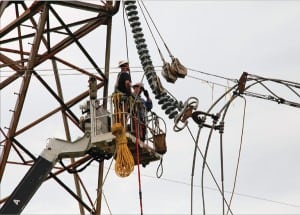Smart Grid
-
Smart Grid
DOE Announces $20M in Funding to Enhance Energy Cybersecurity
The Department of Energy (DOE) last week announced the availability of up to $20 million for the development of tools and technologies to enhance cybersecurity of delivery control systems for electricity, oil, and gas in the U.S.
-
Hydro
FERC Proposes Reforms to Diminish Barriers to Small Generator Interconnection
The Federal Energy Regulatory Commission (FERC) on Thursday proposed four reforms intended to reduce the time and cost to process transmission interconnection requests from generating facilities of 20 MW or smaller. The reforms would boost reliability by increasing energy supply and remove hurdles in the development of new renewable power sources, FERC said.
-
Legal & Regulatory
Terror Threat to Grid Is Real, Says Suppressed Study
A 2007 study sponsored by the Department of Homeland Security confirmed some of the industry’s worst fears about the grid’s vulnerability to terrorist attack. That study has remained under wraps until recently–and its findings are even worse than you may suspect.
-
O&M
Emerging Technologies Enable “No Regrets” Energy Strategy
Achieving a balance between affordable and sustainable electricity while improving reliability is a challenge unlike any the electricity sector has faced since its inception. Technology innovations in key areas such as energy efficiency, smart grid, renewable energy resources, hardened transmission systems, and long-term operation of the existing nuclear and fossil fleets are essential to shaping the future of electricity supplies.
-
Instrumentation & Controls
The Electric Grid: Civilization’s Achilles Heel?
Solar flares have proven destructive effects on transmission grids, but there are many other “black swan events” that threaten modern civilization. Experts disagree about which protective steps should be taken today.
-
Distributed Energy
Improving Grid Resiliency After Superstorm Sandy
For the power generation and delivery industry, the lesson of Hurricane Sandy was how fragile much of the grid is. Distributed generation, smart grid technology, and combined heat and power offer cost-effective ways to improve grid resiliency. -
Smart Grid
Conference Report: 12th ICS Cyber Security Conference
The 12th ICS Cyber Security Conference was held at Old Dominion University’s Virginia Modeling Analysis and Simulation Center (VMASC) October 22–25, 2012. There were approximately 150 attendees from multiple industries, universities, government, and vendors as well as consultants from the U.S., South America, Europe, and Asia.
-
O&M
As Cybersecurity Bill Dies, Newly Declassified Report Underscores Grid Vulnerabilities
Despite growing concern about cybersecurity both in and outside of Washington, the Senate’s cybersecurity bill died a second time on Nov. 13. The apparent inability of Congress to pass legislation designed to protect critical U.S. infrastructure could lead to President Barack Obama implementing some of the bill’s provisions via executive order. A day after the bill failed to gain 60 votes for passage, a recently declassified report was released that finds the U.S. power grid is vulnerable to attacks that could be more destructive than natural disasters such as Hurricane Sandy.
-
Hydro
Hawaii’s Largest Wind Project Online as State Struggles to Integrate Renewables
On Monday, as First Wind announced its 69-MW Kawailoa Wind Project had gone into commercial operations on Oahu, other news underscored the difficulty the island state faces in trying to substitute renewables for expensive, imported fossil fuels.
-
Smart Grid
ABB Announces World’s First Circuit Breaker for HVDC
Switzerland-based ABB today announced that it has developed the world’s first circuit breaker for high voltage direct current (HVDC), solving what it says has been “a 100-year-old electrical engineering puzzle and paving the way for a more efficient and reliable electricity supply system.” The breakthrough holds promise not just for renewables development but also for all types of generation that nations and regions wish to transmit over long distances, including under large bodies of water.

